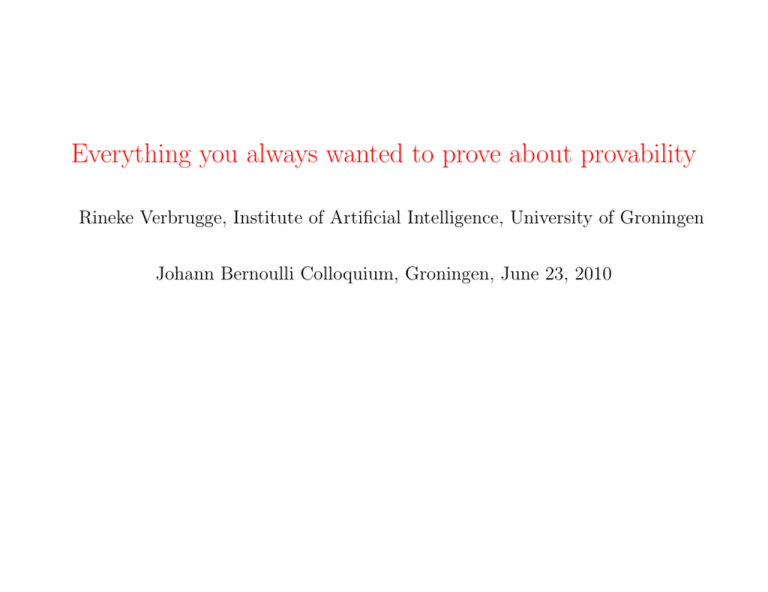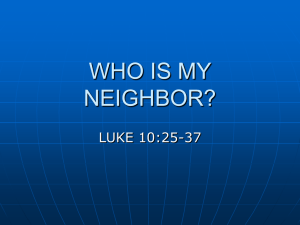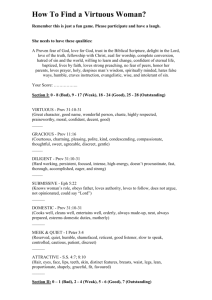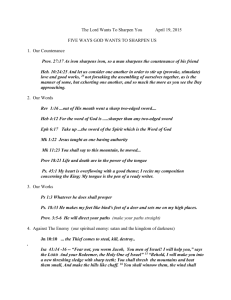Everything you always wanted to prove about provability
advertisement

Everything you always wanted to prove about provability Rineke Verbrugge, Institute of Artificial Intelligence, University of Groningen Johann Bernoulli Colloquium, Groningen, June 23, 2010 Overview • Appetizer: Löb’s paradox • Some pre-history of provability logic: foundations of arithmetic • Syntax and semantics of provability logic • Modal soundness and completeness: syntax ≡ semantics • Solovay’s arithmetical completeness theorem: provability logic ≡ Peano Arithmetic • Löb’s Theorem and Gödel’s Second Incompleteness Theorem • Later developments • Material for this talk is based on: Rineke Verbrugge, Provability logic, Stanford Encyclopedia of Philosophy, Ed Zalta (ed.), Winter edition 2010. Löb’s paradox Let B be any sentence. Let A be the sentence “If A is true, then B is true”. Now we reason as follows: 1 A is true (assumption) 2 If A is true, then B is true (by definition of A) 3 B is true (from 1 and 2, by modus ponens) So we proved that 3 follows from assumption 1. But that means that we derive, without any assumption: 4 If A is true, then B is true 5 A is true (4 is just what A says! ) 6 B is true (from 4 and 5, by modus ponens) Historical developments in foundations of mathematics • 1889 Peano defines a formal language for arithmetic. • 1893 Frege publishes Grundgesetze der Arithmetik. • 1901 Russell shows that Frege’s system is inconsistent: the “set of all sets A that are not a member of A” leads to Russell’s Paradox. • 1910 Russell and Whitehead publish Principia Mathematica, aiming to provide solid logical foundations for mathematics, even reducing mathematics to logic. • 1920s Hilbert’s Program: Aimed at formalization of all of mathematics in axiomatic form, together with a ‘finitistic’ proof that this axiomatization of mathematics is consistent. Historical developments, continued • 1931-1932 Gödel gave a blow to Hilbert’s Program by proving two incompleteness theorems. David Hilbert (Kn̈ingsberg, 1862 - Göttingen, 1942) Historical developments, continued On these and related developments, read Doxiadis, Papadimitriou, Papadatos and Di Donna, Logicomix: An epic search for truth. Russell about the set of all sets that do not contain themselves as a member. Peano Arithmetic (1889) The language of Peano Arithmetic contains 0, S, +, ·, = and ≤. Axioms: ∀x(¬(Sx = 0)) ∀x∀y(Sx = Sy → x = y) ∀x(x 6= 0 → ∃y(y = Sx)) ∀x(x + 0 = x) ∀x∀y(x + Sy = S(x + y)) ∀x(x · 0 = 0) ∀x∀y(x · Sy = (x · y) + x) ∀x∀y(x ≤ y ↔ ∃z(z + x = y)) (A(0) ∧ ∀x(A(x) → A(Sx))) → ∀xA(x) (Induction scheme) Giuseppe Peano (Spinetta 1858 - Torino 1932) The author of Formulario Mathematico in 1930 Gödel’s meta-mathematics of Peano Arithmetic Gödel (1931) arithmetized the formal arithmetic given in Principia Mathematica. The procedure works similarly for Peano Arithmetic. Let pAq denote the Gödel number of arithmetical formula A, the result of assigning a numerical code to A. Let Proof be the formalized proof predicate of Peano Arithmetic. Proof(p, x) stands for “Gödel number p codes a correct proof from the axioms of Peano Arithmetic of the formula with Gödel number x”. Let Prov be the formalized provability predicate for Peano Arithmetic, which is of the form ∃pProof (p, x). Kurt Gödel (Brno 1906 - Princeton 1978) “A friend of Einstein’s, Gödel found a hole at the center of mathematics.” Löb’s three derivability conditions In 1955, Löb formulated three conditions on the provability predicate of Peano Arithmetic. Derivability of A from Peano Arithmetic is denoted by P A ` A: 1. If P A ` A, then P A ` Prov (pAq); 2. P A ` Prov (pA → Bq) → (Prov (pAq) → Prov (pBq)); 3. P A ` Prov (pAq) → Prov (pProv (pAq)q). These Löb conditions cry out for a modal logical investigation, where the modality 2 stands for provability in PA. Löb used them to prove that Prov(pBq) → B can only be proved in PA in the trivial case that PA already proves B itself. Martin Löb (Berlin 1921-Annen 2006) As professor at the University of Amsterdam, 1978 Propositional provability logic: language The logical language of propositional provability logic contains propositional atoms and the usual truth-functional operators ∧, ∨, ¬, →, ↔, as well as the contradiction symbol ⊥. New is a modal operator 2 with intended meaning “is provable in T,” where T is a sufficiently strong formal theory, let us say Peano Arithmetic (PA). Axioms and rules of propositional provability logic Propositional provability logic is often called GL, after Gödel and Löb. The logic GL contains the axioms: • All instantiations of propositional tautologies; for example, 2p → 2p is such an instantiation • 2(A → B) → (2A → 2B) (Distribution, corresponds to second derivability condition) • 2A → 22A (Corresponds to third derivability condition) • 2(2A → A) → 2A (Löb’s axiom) Axioms and rules of propositional provability logic, contd. Furthermore, GL is closed under the following rules: • If GL ` A → B and GL ` A, then GL ` B (modus ponens) • if GL ` A, then GL ` 2A (Generalization; corresponds to first derivability condition) NB It is in general not the case that GL ` A → 2A! The notion GL ` A denotes provability of a modal formula A in propositional provability logic. Possible worlds semantics A possible worlds model (or Kripke model) is a triple M = hW, R, V i, where W is a set of possible worlds, R is a binary accessibility relation on W , and V is a valuation that assigns a truth value (0 or 1) to each propositional variable for each world in W . The notion of truth of a formula A in a model M at a world w ∈ W , notation M, w |= A, is defined inductively: • M |= p iff Vw (p) = 1 • M |= A ∧ B iff M, w |= A and M, w |= B • M |= ¬A iff not M, w |= A • (Similarly for ∨, →, and ↔) • M, w |= 2A iff for every v, if wRv, then M, v |= A Modal soundness and completeness of GL Krister Segerberg proved in 1971 that GL is sound and complete with respect to Kripke models on finite transitive irreflexive trees. Soundness: If GL ` A, then for all Kripke models M = hW, R, V i with finite W on which R is a transitive irreflexive tree, and for all w ∈ W , it holds that M, w |= A. Completeness: If for all Kripke models M = hW, R, V i with finite W on which R is a transitive irreflexive tree, and for all w ∈ W , it holds that M, w |= A, then GL ` A. Decidability of GL The modal soundness and completeness theorems give rise to a decision procedure to check in a finite time for any modal formula A whether A follows from GL or not: Enumerate all GL-proofs P1, P2, P3 . . . and enumerate all finite transitive irreflexive trees T1, T2, T3 . . .. Check alternately for i = 1, 2, . . .: Is A is the conclusion of Pi? If not, does A have a counter-model on tree Ti? Stop as soon as you find a positive answer. Decidability of GL in PSPACE More precisely, GL is decidable in computational complexity class PSPACE: there is a Turing machine that, given a formula A as input, answers whether A follows from GL or not. The size of the needed memory is only polynomial in the length of A. This procedure works by methodically constructing a semantic tableau: a possible counter-model against A, on a finite tree. Arithmetical soundness and completeness GL is an adequate modal logic for Peano Arithmetic: GL proves everything about provability that can be expressed in a propositional modal language and can be proved in PA. More precisely: Let a translation be a function f that assigns to each propositional atom of modal logic a sentence of arithmetic, where: • f (⊥) = (0 = 1) • f (A ∧ B) = f (A) ∧ f (B) (and f similarly respects ∨, ¬, →, ↔) • f (2A) = Prov (pf (B)q) Solovay’s arithmetical completeness theorem (1976) GL ` A iff for all translations f , PA ` f (A) Robert Solovay (1938 -) Solavay in 1972 Arithmetical soundness, part 2: Diagonalization Gödel’s Diagonalization lemma For any arithmetical formula C(x) there is an arithmetical formula B such that: PA ` B ↔ C(pBq) Formula B says “I have property C.” (Self-reference) For Gödel’s First Incompleteness Theorem, one uses a formula B with: PA ` B ↔ ¬Prov (pBq), “I am not provable from PA”. It turns out that B is not provable in PA, and is therefore true. Arithmetical soundness, part 3: Löb’s Theorem Löb’s theorem Suppose that PA ` Prov (pAq) → A, then PA ` A. Proof By the Diagonalization lemma, there is a formula B such that PA ` B ↔ (Prov (pBq) → A). From this it follows by Löb’s first and second derivability conditions plus some propositional reasoning that: PA ` Prov (pBq) → Prov (pProv (pBq) → Aq). Thus, again by Löb’s second condition, PA ` Prov (pBq) → (Prov (pProv (pBq)q) → Prov (pAq)). Arithmetical soundness, part 4: Löb’s Theorem, cntd. So far, PA ` Prov (pBq) → (Prov (pProv (pBq)q) → Prov (pAq)). On the other hand, Löb’s third condition gives: PA ` Prov (pBq) → Prov (pProv (pBq)q), thus PA ` Prov (pBq) → Prov (pAq). Together with the assumption that PA ` Prov (pAq) → A, this gives PA ` Prov (pBq) → A. Finally, the equation produced by Diagonalization implies that PA` B, so PA ` Prov (pBq), thus, applying Modus Ponens, PA ` A, as desired. QED Proof of Gödel’s Second Incompleteness Theorem Gödel’s Second Incompleteness Theorem says: If PA is consistent, then PA cannot prove its own consistency. Formally: Gödel’s Second Incompleteness Theorem If not PA ` 0 = 1, then not PA ` ¬Prov (p(0 = 1)q) Proof Löb’s Theorem says: If PA ` Prov (pAq) → A, then PA ` A. Substituting 0 = 1 for A in Löb’s theorem, we derive that PA ` ¬Prov (p0 = 1q) implies PA ` 0 = 1, which is just the contraposition of Gödel’s Second Incompleteness theorem. Later developments: boundaries of provability logic Weaker systems than Peano Arithmetic may correspond to functions computable in interesting complexity classes. ∆0-formulas are arithmetical formulas in which all quantifiers are bounded by a term, for example ∀y ≤ SS0 ∀z ≤ y ∀x ≤ y + z (x + y ≤ (y + (y + z))). The arithmetical theory I∆0 is similar to Peano Arithmetic, except that induction, (A(0) ∧ ∀x(A(x) → A(Sx))) → ∀xA(x), is restricted to ∆0-formulas A. Let EXP be the formula expressing that for each x, its power 2x exists. Let Ω1 be the formula expressing that for each x, its power xlog(x) exists. Is GL the provability logic of weak systems of arithmetic? For such weak theories T , the translation f should translate 2 to the relevant Prov T . De Jongh, Jumelet and Montagna (1991) proved that arithmetical completeness holds for T= I∆0+EXP: GL ` A iff for all translations f , I∆0+EXP ` f (A) Open question Does arithmetical completeness also hold for T =I∆0 + Ω1? (Partial answers in Berarducci and Verbrugge 1993). Conclusion For PA and many other arithmetical theories, provability logic proves everything you always wanted to prove about provability. Further reading Foundations of mathematics • Doxiadis, A., Papadimitriou, C., Papadatos, A. and Di Donna, A., Logicomix: An Epic Search for Truth. • Hofstadter, D., 1979, Gödel, Escher, Bach. • Nagel, E. and Newman, J.R., 1958, Gödel’s Proof. Provability logic • Boolos, G., 1993, The Logic of Provability. • Smorynski, C., 1995, Self-reference and Modal Logic. • Verbrugge, R., 2010, Provability logic, Stanford Encyclopedia of Philosophy.






